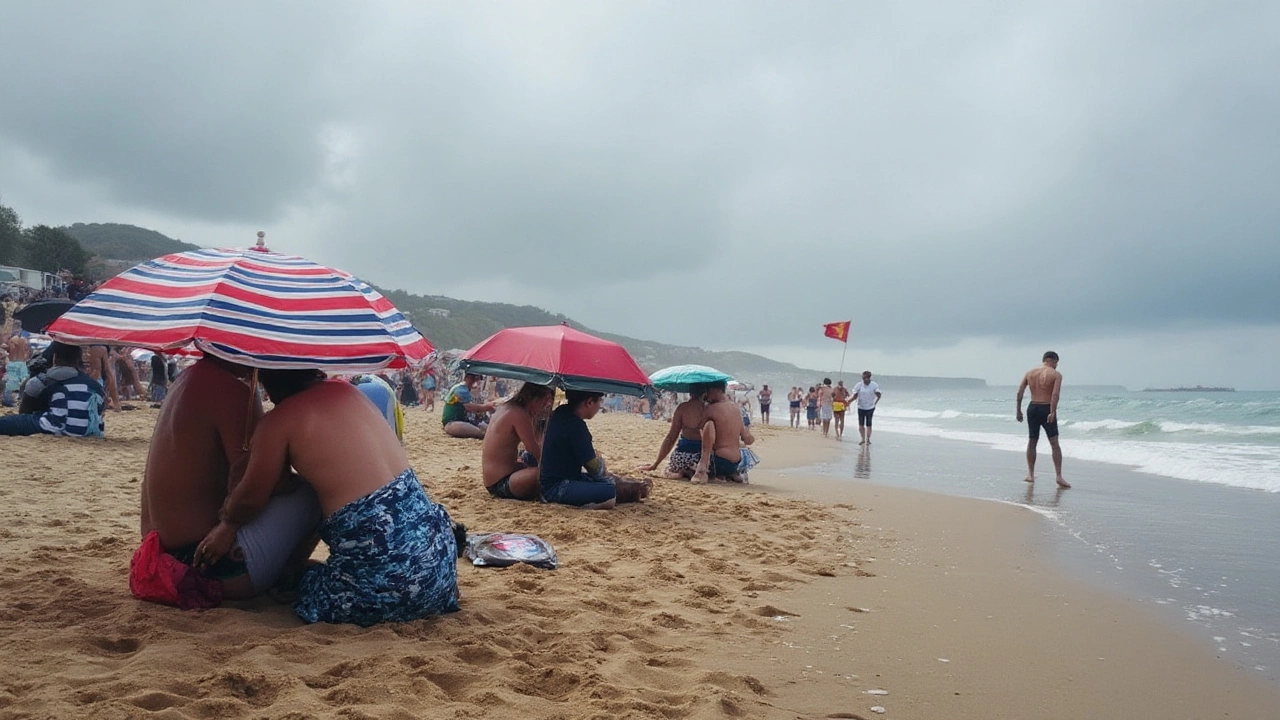Ah, the allure of the beach vacation. The sun-drenched skies, the rhythmic serenade of waves, the sandy toes—it sounds like paradise, doesn’t it? However, not everything is as perfect as those glossy travel brochures might have you believe.
Among the glittering reflections on the ocean surface, there are hidden ripples of inconvenience that every beachgoer should be ready to face. From surprise rain showers to the bustling crowds that descend upon your stretch of sand, beach vacations have their challenges.
What might seem like a minor inconvenience at first, such as sand working its way into every nook and cranny of your belongings, could become a significant annoyance. And let’s not overlook the potential costs that can quickly turn a relaxing day at the beach into a hefty bill.
But don't let this deter you. With a little preparation and awareness, you can handle these potential pitfalls and still have that picture-perfect seaside experience. Here’s a deeper look at what to watch out for on your next beach holiday.
- Crowded Shores and Limited Privacy
- Weather Challenges and Surprises
- Safety Concerns and Ocean Risks
- The Sand Conundrum
- Costly Beachfront Accommodations
Crowded Shores and Limited Privacy
The promise of a serene escape to the sea often runs into the reality of busy beaches, particularly during peak travel seasons. Crowded shores can dramatically alter your vacation experience, turning what was meant to be a tranquil getaway into a bustling hive of activity. On most Saturdays during the summer, popular beaches like Miami’s South Beach or Australia's Bondi Beach witness overwhelming numbers of visitors, all vying for a spot on the sand. This hustle not only affects your chance of finding a secluded corner but also increases noise levels to a point where relaxation is nearly impossible. When everyone brings their music, conversation, and games, the idyllic sound of lapping waves must compete for your attention.
Limited privacy becomes a substantial concern when you find yourself close neighbor to strangers. Whether trying to read a book, nap, or simply enjoy the view, it’s often hard to escape the feeling of being in a public spectacle. Imagine trying to have a quiet conversation or a private moment with your travel companion, only to be interrupted by volleyballs flying your way or inquisitive children peering over your beach blanket. It's a situation that can easily lead to frustration if you're unprepared for it. According to Dr. Julianne Holt-Lunstad, an expert in social interactions, "The psychological benefits of solitude and relaxation need to be harnessed by creating boundaries, but on a crowded beach, these boundaries are inherently compromised."
Interestingly, surveys have shown that 57% of beachgoers express disappointment when beaches are at full capacity, stating that it diminishes their enjoyment and forces them to consider other, often less convenient, locations. Considering this, it makes sense to plan and research thoroughly before your trip. Seek out less popular beaches, which might not have the same amenities but will offer more space and peace. Modern technology can aid your quest for solitude as well. Several apps provide real-time data on beach crowd levels, helping you plan accordingly. Early mornings or late evenings are also opportune times to visit, as they tend to be less congested.
While some of us enjoy a social atmosphere where laughter and chatter fill the air, others might prefer a more solitary setting. No matter your preference, understanding the rhythm of beach vacation crowds can help you navigate the ebb and flow of people. With a balanced approach, you can still discover your perfect slice of paradise.
Weather Challenges and Surprises
When daydreaming about your ideal beach getaway, mostly filled with azure skies and a perfectly golden sunset, it’s easy to overlook the *strong* weather challenges often associated with coastal climates. A place that seems like sun-washed paradise can quickly morph into a scene from an unexpected shower, reminding us of how unpredictable nature can be. Weather in beach destinations can change at the drop of a hat, and planning around it might require more than just checking the forecast the night before.
Take, for example, tropical destinations renowned for their inviting beaches and warm sunshine, such as Southeast Asia or the Caribbean. These areas are frequently hit by sudden rainfalls due to their tropical climate, especially during monsoon seasons or hurricane months. Such climate challenges can not only dampen your beach day plans but also lead to hazardous conditions. Flooding or storm surges might leave visitors stranded or facing extended periods of rough seas, which can disrupt travel schedules. As per a study conducted by the National Oceanic and Atmospheric Administration (NOAA), these unpredictable weather changes significantly impact tourist satisfaction, a key factor that travelers should keep in mind when booking.
Another factor to consider is the persistent coastal winds, known to surprise beachgoers more intent on relaxation than wrestling sun umbrellas and chafing under sand-blasting gales. It’s worth exploring how the coastal wind patterns generally work and if any advisories are in place. The romantic idea of breezy, sun-kissed strolls could be temporarily blown away, as resort towns sometimes experience strong gusts that make it tricky to enjoy an al fresco meal or a serene nap by the shore. And these winds, while occasionally refreshing, can serve as a conduit for changing weather fronts, often bringing with them those light, unanticipated rains.
To help mitigate weather surprises during your vacation, always arm yourself with essential travel apps that provide real-time updates and alerts. Apps like Weather Underground or AccuWeather offer localized forecasts that are crucial when planning your day around potential storm clouds. Equipping yourself with a sturdy raincoat or a collapsible umbrella might sound like over-preparation, but being ready for a quick downpour ensures that a little rain doesn’t water down your holiday spirit. For beach lovers intent on catching rays and diving into crystal blue waters, a quick stop at the local visitor’s center could also provide invaluable insight into local weather patterns and safety warnings you won’t find elsewhere.
"Weather is a great metaphor for life. Sometimes it's good, sometimes it's bad, and there's nothing much you can do about it but carry an umbrella." - Terri Guillemets
Preparation is key in turning these potential *drawbacks of beach vacations* into minor blips rather than major stressors. By watching how locals adapt to these conditions, whether through scheduled siestas or adjusted activity times, you can find creative ways to enjoy your holiday regardless of what the sky decides to unleash. Enjoying your favorite beach comes with its share of planning and adaptation, but mastering that balance can transform a simple vacation into a truly memorable escape.

Safety Concerns and Ocean Risks
When you're planning a beach vacation, it’s easy to imagine only the relaxation and beauty lying ahead. However, it's crucial to be mindful of the potential safety concerns and ocean risks that can accompany your seaside escape. One of the most pressing concerns is the presence of rip currents. These strong, narrow channels of fast-moving water can occur at any beach with breaking waves and can quickly draw swimmers away from shore and into deeper waters. Knowing how to recognize a rip current and how to react if caught in one can be life-saving. The National Ocean Service reports that rip currents account for about 80% of beach rescues yearly, highlighting the importance of awareness.
Beyond currents, attention should be directed toward marine life, which can sometimes pose unwelcome surprises. Jellyfish stings are a common issue and can vary in severity from minor irritations to more severe reactions. Wearing protective swimwear and checking local beach advisories can help mitigate encounters. In some regions, more dangerous creatures like sharks or stingrays may reside in the waters. Though shark attacks are rare, with only about 80 unprovoked attacks annually worldwide, it's still beneficial to heed local warnings and beach regulations designed to keep you safe.
Inclement weather is another factor that can transform a seaside paradise into a perilous environment. Tropical storms or sudden thunderstorms may arise without much warning, turning the calmest waters into raging seas. Keeping an eye on weather forecasts and setting up outdoor plans around anticipated weather patterns can be a wise strategy. On many coastlines, lifeguard stations and warning flags provide essential information about water conditions, and adhering to this guidance should not be overlooked.
“The sea, once it casts its spell, holds one in its net of wonder forever.” – Jacques Cousteau
While the ocean is a source of awe and adventure, it's important to enjoy it responsibly. For those who enjoy snorkeling or scuba diving, staying within recommended depth limits and diving spots is key. Equipping yourself with the right gear and diving with a buddy can prevent accidents underwater. Even for those who prefer staying above the waves, factors like dehydration and heatstroke can also pose a threat during a long day under the scorching sun. Drinking ample water, seeking shade intermittently, and applying sunscreen liberally can reduce these risks significantly.
The beach is a marvelous setting for relaxation and recreation, but acknowledging these potential drawbacks—fromsafety concerns to ocean risks—is essential for a worry-free holiday. By taking a few preventative steps and staying informed about your surroundings, you can ensure that your beach time remains blissful rather than bothersome.
The Sand Conundrum
There's something undeniably charming about the feeling of sand between your toes. It speaks of childhood memories building sandcastles or lazy afternoon strolls down the shore. But when the sun begins to set and it's time to shake off that holiday mode, the true nature of sand becomes apparent. It's no longer the friendly earth beneath your feet; it becomes the sneaky stowaway in your suitcase, camera, and even your hair.
Anyone who's spent time at the beach knows that sand gets everywhere. Despite its seemingly harmless nature, once it finds its way into your clothes, bags, and gadgets, it can be quite persistent. This might be partly due to the way sand grains behave—they are designed to stick. Comprising tiny fragments of minerals, it clings to everything with a near-magnetic force. Not only does this make cleaning up after a day at the beach a challenge, it can also lead to unexpected costs if sensitive electronics are affected.
The drawbacks beach holiday enthusiasts often cite about sandy destinations involve those endless attempts to shake, brush, and rinse out sand from shoes, towels, and sometimes even your skin. One well-traveled beachgoer once said, "Sand seems to conspire with the wind to invade every corner of your belongings." This continuous battle against sand even has seasoned vacationers picking their beaches based on sand quality. Fine, powdery sands might look stunning but can be the most troublesome, while coarse grains might be less aesthetically pleasing but easier to manage.
Not only does sand find a way into personal belongings, it sometimes makes its way into places you'd rather it didn't. Cars returning from the beach often tell this tale; it can take weeks to completely rid a vehicle of sand. For those planning beach picnics or setting up elaborate beach tents, anchoring structures against shifting sands presents its own challenges. It requires not just skill but a lot of patience to prevent those embarrassing moments when the wind sends your belongings tumbling.
It's no wonder that reports suggest a significant rise in beach bag designs that feature sand-resistant fabrics or special compartments designed to contain sand. Companies are continuously innovating to cater to this sandy annoyance. In some coastal towns, there's even a burgeoning business for rentals of beach-specific clean-up equipment, like hand vacuums tailored for sandy environments or portable foot showers.
Mitigating the beach vacation cons related to sand largely comes down to preparation. Consider packing a small handheld broom or soft brush for a quick dust-off before getting into the car. Re-sealable bags can be lifesavers, protecting items that sand should never touch, like phones and cameras. Some travelers swear by sprinkling baby powder on sandy skin, a trick that absorbs moisture and loosens the sand's grip. Beware, though, as some beaches consider powder a pollutant and advise against its use.
As much as sand can cause a few headaches, it also holds a sense of charm that is deeply tied to the allure of beach holidays. Apart from the common nuisance, let's not forget the therapeutic effects of walking barefoot on sand, an activity dubbed "grounding," known to reduce stress and improve sleep. So while beach travel tips may help you handle the sands of time, remember it also holds the key to relaxation. Understanding the sand conundrum is as important as the sunscreen in your beach arsenal, a little inconvenience to pay for some of the richest experiences the coast has to offer.

Costly Beachfront Accommodations
Imagine waking up each morning, the scent of salt in the air, the song of seagulls above, and the gentle crash of waves as your alarm clock. This is the dream that beachfront accommodations sell to eager travelers. Yet, the price tag attached to such seaside bliss can be steep, often leaving travelers shell-shocked. Beachfront properties are at the pinnacle of demand, and this demand inevitably drives prices to soaring heights. The exquisite view and direct access to sandy shores justify these high costs for many, turning these properties into prime real estate where luxury meets location.
It’s not just about the initial rate; once you're settled into your picturesque abode, you might find that prices for food, amenities, and activities are even higher than you anticipated. From premium charges for sea-facing rooms to elevated fees for dining in beachside restaurants, these expenses quickly accumulate. A study from 2022 disclosed that a beachfront hotel stay in popular locations cost almost 30% more than similar properties a few blocks away, nudging many travelers to rethink their accommodation choices.
Booking during off-peak times can slightly ease the burden on your wallet. However, even during these periods, beachfront accommodations tend to command a premium price. Travelers often pay for the convenience and instant gratification of being steps away from the sea—a splurge that can impact the rest of their travel budget. Staying a bit farther from the shore and trekking to the beach each day might not offer the same immediacy, but it’s a compromise worth considering when pennies count.
Considering alternatives like vacation rentals or even humble beach cabins can sometimes grant the same vibrant experience sans the extravagant expense. Websites such as Airbnb and Booking.com often have hidden gems that offer proximity to the beach without the extra zeros on the bill. Tapping into local insights through travel forums and blogs might also reveal budget-friendly secrets that travelers miss on typical booking platforms.
For those savvy spenders among us, there are always ways to offset the costs associated with premium beach lodgings. Sharing accommodations with friends or family can make luxurious options more accessible. Engaging with loyalty programs or special deals offered through booking sites can unlock discounts that may transform what's unaffordable into attainable.
One should always weigh both the allure and limitations of such vacation spots before making reservations. The beach may present itself as a picture-perfect escape, but ensuring that you strike a balance between indulgence and prudence will lead to an enriched holiday experience. Planning ahead, utilizing strategic booking experiences, and perhaps even making slight compromises can turn a seemingly costly getaway into a cherished memory.
